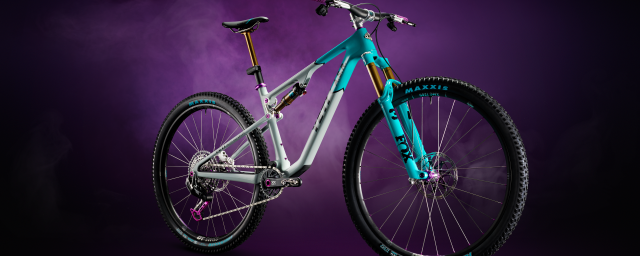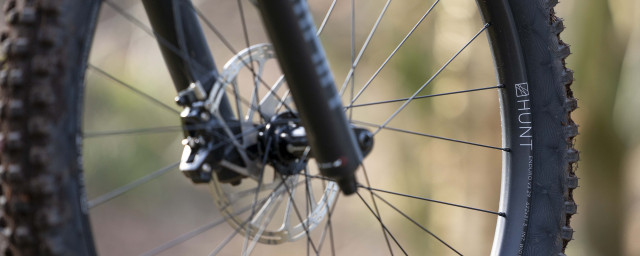
- Superior quality in both build and performance
- Advanced features, the Reflex+ is impressive
- Cable free with sturdy mounting options
- Expensive (totally subjective when considering a premium product)
- Larger size means potentially vulnerable in a crash
The Sixpack is Exposure Lights flagship model and offers 4,750 lumens of nighttime banishing brightness. Now, large lumen counts are nothing new to the night light world but what is exciting, and ultimately most important, is how usable it is.
The Sixpack has a whole host of features and built-in tech to enable you to maximise that output whilst maintaining battery life for as long as possible. Whilst talking batteries, Exposure’s are all built in, meaning no annoying wires and separate packs to strap to the frame or put in your bag. It does mean the light itself is larger and heavier, but, Exposure’s intuitive and sturdy mounting options mean you’ll barely notice that once it's fitted.
At 385g, it's hardly uber-heavy either. I’ve had both the bar clamp and stem mount on test, both work brilliantly and don’t budge at all in use - my favourite being the stem mount, enabling you to utilise existing stem bolts (or the included longer ones) to fix the adjustable bracket and light too. It means you can have the beam directly centralised which, in practice, doesn’t alter the direction of light hugely due to the output power and breadth of beam, but my OCD likes it!
The Sixpack has some very cool built-in tech, like the fuel gauge display on the rear which shows the amount of running time left in the current mode, as well as a couple of other details. The port on the rear (smart port) also has the option to use some plug and play accessories such as an external battery or a remote should you wish.
However, the really exciting inclusion that Exposure has developed is something they call Reflex+, a feature which allows the light to almost think for itself. When in Reflex mode the light will, for the first 15 minutes or so, calculate your riding style and adjust lighting accordingly. For example, most of my riding consists of winching up a hill, and plummeting down the other side, in this instance, reflex + uses movement and wind speed to acknowledge this. The result is a whopping 4750 lumens on the downs, and an automatically dimmed output on the climbs or when at a standstill, all done without you touching a single button. It’ll also remember this style and implement it immediately on your next ride, unless it senses the ride is drastically different, at which point it’ll recalibrate. Most impressively, unlike many other technologies come and gone, this works well, every time. Ultimately, it means you can eek out even more ride time with maximal visibility just when you need it.
The beam emitted from the Sixpack can only be described as a bright white car headlight - its clean, crisp and very, very bright.The entire trail ahead is illuminated with just the right width ensuring very little is bled out into the undergrowth but with huge depth ahead. There’s a series of modes to choose from which is explained in the quick start guide and uses the mode selector button on the rear of the light. This enables you to choose from a variety of set-ups and burn times for each output level. I’ve been running it almost entirely in reflex mode 1 which gives me nearly a 3 hour burn time utilising that whopping 4750 lumens on every down. Out of Reflex mode, the consistent power output is reduced to 3600 lumens to allow a reasonable burn time, otherwise the battery would be used very quickly. Even at this output, the quality of the LED’s used by exposure is obvious, which far exceed the penetration displayed by more powerful and cheaper lights. We’ve all heard it before - its how you use it that counts!
Charge time is on the long side at about 12 hours from fully flat (charge time is neatly displayed on the rear screen too), not a problem if you remember to leave it on charge, which you can do overnight, time and time again and it shouldn’t burn your house down. Its a premium, quality product. Now, of course, that premium level of lighting comes at a price, it’ll cost you circa £425 to purchase a new Sixpack. But then that’s the point, right? Exposure’s flagship is the perfect example of ‘you get what you pay for’ and based on Exposure lights of old, that are still going strong, it should be worth the investment should you wish to continue your biking addiction throughout the darker months. One other downside is that due to its size and mounting location, it is rather vulnerable and its a lot of money for something you may smash off in a mud cuddle. That said, the bracket is likely to be the sacrificial part, the casing is anodised and sturdy, plus you’ll always be able to find it in the darkness should it roll into the bushes.
When concluding, and in remaining objective, price, size and vulnerability of the Sixpack will always be points of questioning, however, quite simply, if you want the best in the business, you need look no further. It is a level of lighting and quality construction that far exceeds nearly all of the competition.















1 comments
I agree that it’s not cheap but I’ve had my two Exposure lights (one bar, one lid fitting) for literally longer than I can remember (ie years and years). When the main one had a charging issue a few years back Exposure repaired it for nothing even though it was well out of guarantee period. Get what you pay for.